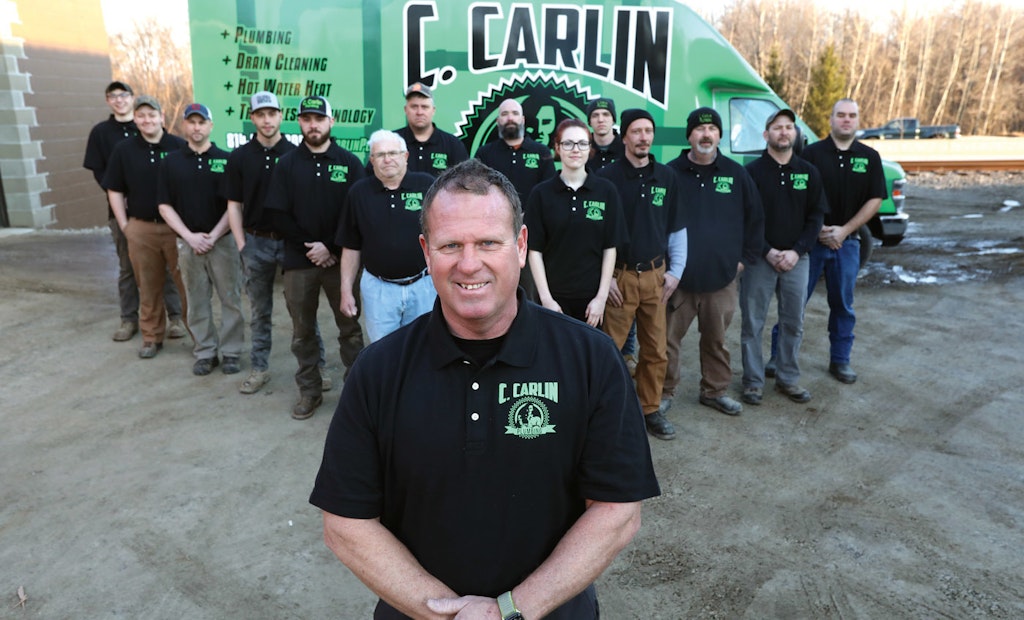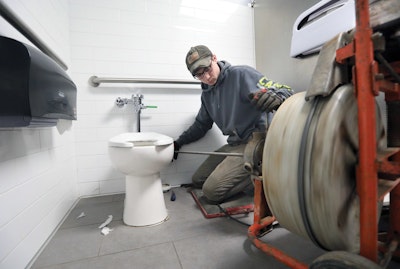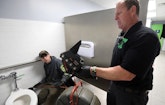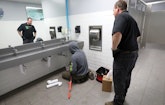
Chris Carlin, founder and owner of C. Carlin Plumbing, stands with his employees (from left) Ben Kuzma, Devyn Hopson, Anthony Desser, Cody Flinn, Trevor Reed, Bill Hilbert, Doug Moyer, Scott Benim, Camille Scarabino, Kyle King, Chris Bane, Marc Prindle, Dewey Desser, and Billy Krawczyk.
Interested in Cleaning?
Get Cleaning articles, news and videos right in your inbox! Sign up now.
Cleaning + Get AlertsChris Carlin never had any thoughts of going into the drain cleaning and sewer services industry, but after years of doing new construction plumbing, a change was in store.
“A friend of mine was a sewer inspector. He said I should really consider getting a sewer camera because the townships and municipalities around the county were making changes and doing inflow and infiltration inspections and giving up the responsibility of the lateral from the house to the road,” says Carlin, owner of C. Carlin Plumbing. “They were changing the ordinance to the laterals being the homeowners’ responsibility to maintain.”
That was in 1996. Now, the Erie, Pennsylvania-based company’s drain cleaning and sewer services encompass about 60% of the yearly revenue. The company also offers typical plumbing services and hydroexcavation.
“It’s just a completely different world in the plumbing industry that we do now compared to what we did before,” Carlin says. “We were going to new houses, drilling holes and putting in new pipe. Now we do a lot of small commercial work, and sewer and drain cleaning. A lot of stuff has changed over the years.”
Finding his way
That roller coaster started in the early 1980s when Carlin was working for another local plumber right out of high school. Carlin, who had no background in plumbing and no family history in the industry, was working for a friend’s dad. As a young man just out of school, Carlin assumed since he knew the owners so well, he would be considered family.
“I was working along for six or nine months and the boss pulled me aside and wanted me to stay after and talk,” Carlin says. “I thought I was going to get a big raise, but I go in and here he tells me if I didn’t shape up, this business wasn’t for me. He gave me six months. It surprised me.”
Carlin was told he had an attitude problem, but thought he was just one of the guys joking around with the older plumbers. He was also told he was afraid to try new things and he shouldn’t be.
“He told me there was nothing I could screw up that couldn’t be fixed,” Carlin says. “He wanted me to start being more respectful to the older guys, and he wanted me to start doing work for my family and friends, like side jobs. It was the best way to learn.”
Carlin took the advice to heart, and within a year he was supervising his own crew.
“He kind of created a monster because I started doing side jobs left and right, and that’s all I did,” Carlin says. “I told everybody I was a plumber and I could fix it. I started doing side jobs, and then 12 years later it just got out of control because I was working 70, 80, 90 hours a week.”
That year his boss called him in again, praised him for the work he was doing but told him he couldn’t do new construction on the side anymore. That is what the company’s focus was and the owner of the company didn’t want to lose work.
“I was doing two to three new houses a year and that was the company’s bread and butter,” Carlin says. “That year, I did two more houses for him that were my jobs I already had in the bag and I thought this was kind of crazy. That’s when I decided it was time to move on.”
With his wife pregnant with their second child, Carlin pulled the trigger and started his own company in 1994.
“Back then I was about 95% new construction,” Carlin says. “As things developed and I got into business, there was more demand for different things, and next thing you know, I’m doing sewer work and it’s something I never thought I would do. One thing led to another from there.”
A new market
Two years after starting his company, Carlin broke into the sewer and drain side of the industry. Communities within his service area were tightening up wastewater systems and found through I&I studies that most of the water infiltrating the system was coming from homeowners.
“I bought my first sewer camera and hardly anyone in town had one, so I got a majority of the work right out of the gate and started doing camera inspections,” Carlin say. His first camera was RIDGID system with a small black-and-white screen. He still has that old system but also has three newer ones as well.
Very quickly he learned he couldn’t inspect a drain if there was no way through it, so he bought a snake “It has continued to snowball over the last 20 years with equipment,” Carlin laughs.
In 2003 Carlin found his way to the Pumper & Cleaner Environmental Expo (now the Water & Wastewater Equipment, Treatment & Transport Show). He was looking for ways to do all of the I&I work he was getting without having to dig up floors and yards.
“Some of the locations were just impossible to get to doing that work,” Carlin says. “I was trying to find a way to do spot repairs because I didn’t want to dig a huge hole just to repair a small hole in a pipe.”
It was there at the Pumper & Cleaner Environmental Expo that Carlin found CIPP and began working with Nu Flow Technologies. He became a licensed installer through them in 2005.
“We were pushing CIPP because of the camera work we were doing,” Carlin says. “We did a lot of inspections because I was one of the few guys who had a camera.”
One of his first jobs after taking on camera and CIPP work came soon after when a local municipality was starting a program where every real estate transaction needed to have a sewer inspection done. The first inspection failed and the first plumber on the job called upon Carlin to take a look because he was going to dig it up and put a new lateral in.
Instead, Carlin showed him CIPP and his work in that municipality took off, as there was a 75% failure rate on the inspections on the sewer laterals. For its CIPP work, the company uses Picote Solutions, MaxLiner USA and Nu Flow materials.
“We can do spot repairs, but mostly we are relining 60- to 100-foot lines,” Carlin says.
A ripple effect
Adding the drain and sewer services created even more work for C. Carlin Plumbing.
“I have an account now that probably gives us over 100 grand a year, and its not just drain cleaning work,” Carlin says. “They liked the work we were doing for them so much that within the last two years, they’ve handed over all their plumbing work to us. We now do 95% of that company’s plumbing; it’s all commercial.”
Carlin also does work for a builder who originally hired him out for drain cleaning services and plumbing repairs. In 2018, Carlin earned a contract from the builder to do all the plumbing installation for a new rural retirement community — a 16-patio home.
He has also added high-pressure jetting and hydroexcavation to his company’s offerings. He bought his first jetter — an O’Brien (Hi-Vac) — in order to clean the bigger sewer lines in the area and then bought a Vermeer trailer vacuum excavation unit in order to get the debris out of those lines.
“And now we do utility locating for other companies too with our trailer units,” Carlin says. “Almost all of the work we do now comes from doing work in drain cleaning and camera inspections. A lot of things we do now lead back to that.”
The company is using some of that equipment on a job currently in a local municipality where all the 900 homes in the community are getting hooked up to sewers. While Carlin’s company isn’t installing the mainlines, they are taking on much of the residential hookups.
“Right now out of 130 installs in the township, we’ve done 50-some,” Carlin says. “There are other companies doing it too, but we have a majority of it. We have 43 alone on the books for this year and they can’t even hook up yet because they don’t have their commitment letter. Once they get that, we’re set to go.”
A committed crew
Handling all of this work for the company is a team of 14, including Carlin, who still enjoys going out on calls as well.
“I don’t like the office — I won’t lie,” Carlin says. “Everybody here knows I’m not a pen and paper kind of guy. I’m in the field every day. If I show up to a dig, I’m in the ditch.”
Helping in the office are two full-time employees, including his son-in-law Billy Krawczyk.
“Billy worked in the field for five or six years himself,” Carlin says. “He went to school for accounting and started out on the plumbing side for a long time and graduated into helping at the office. He knows the plumbing industry so that helps when he’s doing invoicing or billing. He gets it because he’s been out there doing it.”
That leaves the remaining 11 crew members in the field. Typically there are two to a crew, but service crews are running one member a lot of the time.
“I have a couple guys who are just dedicated to the drain cleaning, camera and jetting work, and then I’ve got a couple other plumbers who float in and out of both drain cleaning and typical plumbing,” Carlin says. “I try to get all my drain cleaning guys working in the plumbing end too because they need to know how it’s designed from the get-go, in order to learn how to clean it.
Into the steam
Not all of the jobs handled by C. Carlin Plumbing are easy commercial jobs cleaning out a line or replacing a lateral. Some have proven to be more challenging, especially at the local bakeries the company provides services to.
With so much sugar and syrup running through the pipes to form the jellies and jams for the pastries, pipes tend to deteriorate quickly. In winter 2018, Carlin was called to one of the bakeries where the bottoms of the pipes wore out.
“The pipes were within a cement platform that is about 4 feet off the ground with a ton of equipment in it,” Carlin says. “It’s called their cooking platform.”
On top of the platform sit three big mixing bowls that all the jellies flow into for mixing and ultimate inserting into the confections. Running under and above the mixing bowls are steam units to heat it. The piping that needed to be replaced was under all of this equipment, which could not be shut down.
“We were getting gravel back every time we snaked or jetted it,” Carlin says. “So we knew the pipes were gone. We ran a CCTV on it and knew we had to replace a section of it.”
Crews taped off a 10-by-12 area, cut a hole in the floor about 6 foot by 4 foot and then tunneled under the platform to get to the pipes and cut them out with Sawzalls (Milwaukee Tool) for replacement.
While the repairs were being done, the bakery was never shut down.
“The steam was blowing and it looked like I had a facial by the time we were done,” Carlin says. His crews had the job completed in three days. “It was a pretty difficult situation. Probably the hardest work I’ve ever done has been at this bakery and all the jobs have been similar.”
Diversification continues
Carlin isn’t afraid to say that his company has had to reinvent itself several times in the last 15 years. “We did new construction at first; now we do all of it,” he says. “It’s changed dramatically.”
Carlin says it’s important to pay attention to what is going on in the industry and look at what the market is around the service area.
“You have to adapt to what that market is,” Carlin says. “But you can’t do it all, and you can’t do just one thing either. You definitely need to have a niche — your bread and butter — but you have to be able to diversify and do more than just one thing or you can’t make it in this world.”
Making payments easy for customers
While C. Carlin Plumbing has undergone several changes within the last 15 years, this past year owner Chris Carlin wanted to make one change that would make life easier for his customers.
That change was a simple one: adding Payzer to his company’s website. Payzer is an online tool for contractors that allows customers to pay through the website.
“We’re breaking people into it and getting them used to it,” Carlin says. “We’re finding people like to use a credit card for everything in this day and age. Nobody has cash on hand.”
The tool also helps customers pay for what they want instead of only what they can afford at that time by offering financing options.
“If somebody wants a tankless water heater, but they can only afford a tank style, we’ve got this tool to offer them and maybe they can get it then,” Carlin says. “If we get someone signing up for Payzer, it’s that price they are quoted and it’s that price all the way through.”
It takes customers five minutes to be approved through the online portal. And when a customer is approved — which is easy to do — Carlin’s company is issued a check immediately for the entire cost of the project.
“We get one lump sum from Payzer,” Carlin says. “The customer then makes payments to Payzer.”
Carlin found the tool from one of his suppliers that also uses it. “I think people would find out they could sell a lot more product and offer a better product with a service like this.”










